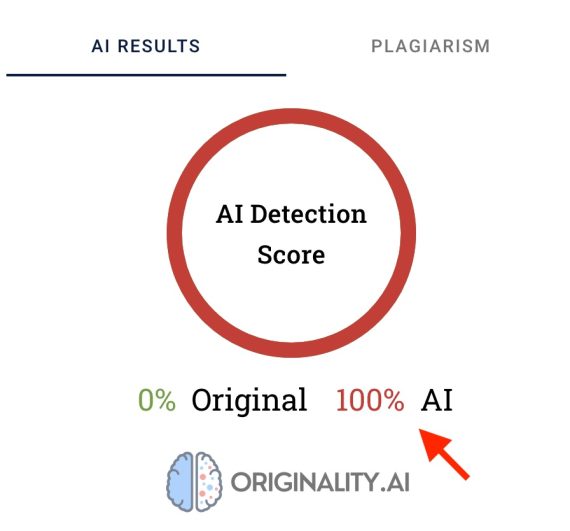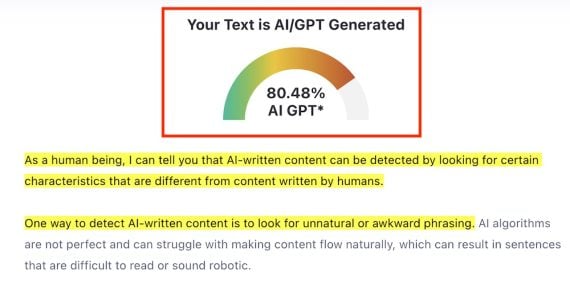Using artificial intelligence tools to generate organic-search content is debatable owing to Google’s evolving guidelines.
AI can produce quality text — articles, descriptions — but it’s not always accurate and usually detectable. Likely that content will become more accurate and less detectable. But the tools I’m aware of — ChatGPT, Jasper, others — while impressive, are not yet infallible.
Thus AI text detectors remain useful. In this post, I’ll test the detectors.
I started by entering this prompt into ChatGPT:
Please explain how AI-written content can be detected. Please explain as if you were a human being.
Here is ChatGPT’s response:
As a human being, I can tell you that AI-written content can be detected by looking for certain characteristics that are different from content written by humans.
One way to detect AI-written content is to look for unnatural or awkward phrasing. AI algorithms are not perfect and can struggle with making content flow naturally, which can result in sentences that are difficult to read or sound robotic.
Another clue that content was generated by AI is a lack of nuance or context. AI algorithms work by analyzing large datasets to identify patterns and relationships between words, but they may not understand the nuances of language in the same way that humans do. As a result, AI-generated content may lack the depth of understanding and context that human-written content can provide.
Additionally, if the content is generated by a particular software, there may be certain markers or characteristics that are specific to that software. For example, some AI-generated content may have a particular style or format that is consistent across multiple pieces of content.
Overall, while AI-generated content can be useful for certain tasks, it is important to be able to distinguish between content generated by humans and content generated by AI, in order to ensure accuracy and avoid misleading readers.
I then pasted ChatGPT’s response — 1,301 characters, 210 words — into 10 AI content detectors.
10 AI Tests
OpenAI Detector is ChatGPT’s official content detector. It is free and requires only a login to use. Having entered the above response, the tool replied, “… likely AI-generated.”
OpenAI Detector
—
Originality.ai is a premium tool that checks for both AI-written and plagiarized content. It costs $0.01 per credit to check one or the other — or $0.02 for both.
The platform supports only English. It reported the ChatGPT response as “100%” AI-generated.
Originality.ai
—
Sapling AI Content Detector offers a free version, requiring no login, to check up to 2,000 characters. The tool detected the ChatGPT text as “Fake: 100%.”
Sapling AI Content Detector
—
Writer AI Content Detector’s free version checks up to 1,500 characters. The tool reported the ChatGPT text as “78% human-generated.”
Writer AI Content Detector
—
ZeroGPT is a free ChatGPT content detector that claims a 98% accuracy. The tool highlights what it detects as AI-generated sentences in yellow. In my test, ZeroGPT reported that only 81% of the content was “AI GPT” generated.
ZeroGPT
—
CheckforAI requires a sign-up. The free version tests 350 to 2,500 characters. It identified my text as “high risk” — “partially or entirely written by AI” — with a helpful color-coded analysis.
CheckforAI
—
Content at Scale is a free tool for detecting “robotic” content. It reported my ChatGPT text as “partially created by both a human being and an AI tool.”
Content at Scale
—
Copyleaks is a free AI text detection tool that claims 99% accuracy. My text earned a 96.2% probability of being AI-generated. It correctly identified all of my text as AI-created.
Copyleaks
—
GPT-2 Output Detector is an original AI detection tool. It works well with the GPT-3 version and identified my text as “99.26% fake.” The tool allows for real-time editing with immediate detection updates.
GPT-2 Output Detector
—
Crossplag is a premium plagiarism detector with a free version that also identifies AI-produced text. I pasted the ChatGPT response into the tool, which reported, “The text is mainly written by an AI.”
Crossplag
Accuracy
All of the tools in my test detected the AI content — some better than others. Thus, for accuracy, running several tools is a good idea.










